The Supramonte is a large limestone area, orographically complex, it covers the area from the Gulf of Orosei until over 20km to the inside. We are talking about 340 km² of limestone, with formations from middle jurassic to middle cretaceous (about 165-145 million years ago).
The mountain covers the municipalities of Dorgali, Oliena, Orgosolo Baunei, and obviously Urzulei.
Supramonte’s area is eterogeneous, characterized with deep incisions called “Codule”, like the Codula of Elune, or real canyon whose the area of Urzulei is rich of, some little and some of massive dimension like Gorropu Canyon.
The supramonte of Urzulei, represent the most wild part of all the mountain range.
Rugged wals and deep gorges characterize the landscapes of the Supramonte.The water here is an occasional visitor, eager to disappear into the bowels of the earth, below the limestone. Water with its strength is wedged between the mountains and so offers beautiful landscapes and helps make the area rich in high green spots with bushy shrubs and rare junipers. White rocks, parched by the sun and stingy of water. The slow work of time sculpts the limestone and between the wrinkles emerges numerous fossils. The fauna is rich in mouflones, boars, martens and dormouse. A popular destination for hikers in this part of the Supramonte is Codula of Luna: without excessive jumps, gently rolls down to the ample walls that hosts colorful oleanders. The subsoil is rich in caves. The most known is that of Su Palu, long over 35 km, which is one of the largest subsoil extensions of Europe.
In this territory, hostile for human settlements and productivity, the man has been able to adapt.
‘Os coiles’, true works of rural art, are the ancient shepherds’ tents, scattered in the most inaccessible places of the Supramonte, the represent those little realities where even today you can taste the unique traditions and emotions.
